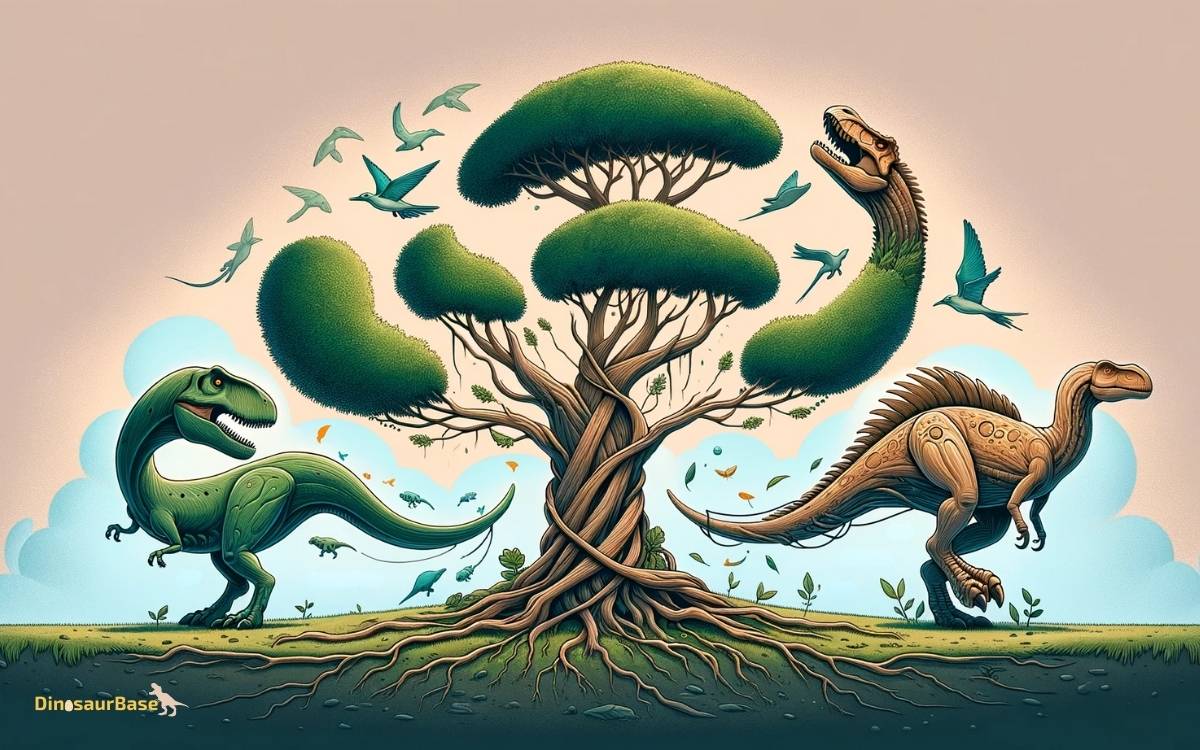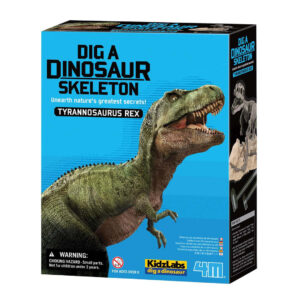What Do Dinosaur Fossils And Tree Rings Have in Common?
Dinosaur fossils and tree rings share the ability to provide historical environmental data. They both serve as records of the past, offering insights into ancient climates and environments.
Exploring our planet’s heritage becomes a fascinating journey through time thanks to the clues locked within dinosaur bones and the concentric layers of trees.
Dinosaur fossils tell of an age millions of years ago, when colossal creatures roamed the Earth, leaving behind skeletal remains that can hint at their lifestyles, diets, and even causes of extinction.
In parallel, tree rings capture a different type of history, with each ring marking a year’s growth, reflecting the conditions under which the tree grew, such as rainfall levels, temperature changes, and even volcanic activity.
For scientists and researchers, these natural archives are invaluable, as they piece together the complex puzzle of Earth’s climatic and ecological evolution. They translate these silent witnesses’ stories into a vivid retelling of our planet’s dynamic history.

Traces Of Ancient Lives
Dinosaur fossils and tree rings are like time machines. They take us back to ancient worlds. We can see how old dinosaurs were when they roamed the Earth. Same with trees. Their rings tell us their age year by year. Both are clues to long-gone life.
Indicators Of Biological Activity
Dinosaur bones and tree rings show us life signs. They hold secrets of growth, environment, and events.
- Dinosaur fossils tell about their size and diet.
- Tree rings reflect the climate they grew in.
Preservations Across Millennia
Fossils and tree rings survive a long time. They are our windows to study the past. Let’s dig deeper into these ancient timekeepers.
| Dinosaur Fossils | Tree Rings |
|---|---|
| Turn to stone over millions of years. | Preserved in dead, old trees. |
| Show evidence of ancient ecosystems. | Indicate historical climate patterns. |

Credit: www.quantamagazine.org
The Science Behind The Formation
To unveil the past, scientists turn to the Earth’s natural archives. Dinosaur fossils and tree rings might seem worlds apart, but they share a common story about Earth’s history.
These natural records have been shaped and preserved through unique processes that allow us to peer deep into bygone eras.
Processes Of Fossilization
Fossilization is nature’s way of capturing a moment in time. It starts when a dinosaur dies. Over time, the creature’s remains undergo transformation. Here’s what happens:
- Burial: Sediments cover the bones quickly, protecting them from the elements.
- Mineral Exchange: Groundwater seeps through, minerals replace bone, creating a stone replica of the original.
- Preservation: The surrounding sediments harden, forming a protective tomb around the fossil.
Growth And Development Of Tree Rings
Meanwhile, tree rings are like diaries that trees keep every year. They tell a tale of survival and growth. Each ring marks a year in the tree’s life.
Here’s a glimpse into their formation:
- As spring begins, trees form new layers of soft, spongy wood called earlywood.
- In the summer, growth slows down and trees produce denser latewood.
- These alternating patterns of growth create visible rings, which can reveal the tree’s age and past climate conditions.
Both fossilization and tree ring development are silent witnesses to the passage of time. These processes have locked away secrets of the ancient world for us to explore and understand.
Tales Told By Time
Dinosaur fossils and tree rings both serve as time capsules. They capture moments in the planet’s history, preserving valuable clues about the past.
Through their silent tales, these remnants of ancient life and growth patterns help scientists unravel the mysteries of ages long gone. Let’s explore the fascinating stories these time markers tell about our world’s history.
Deciphering Historical Climates
Both fossils and tree rings act as historical thermometers. Here’s how:
- Dinosaur fossils provide evidence of past biodiversity, helping experts estimate ancient temperatures that supported such life.
- Tree rings, through their width and density, tell tales of yearly weather patterns, revealing periods of droughts or ample rainfall.
| Marker | Climate Data | Period |
|---|---|---|
| Dinosaur Fossils | Biodiversity Levels | Millions of Years Ago |
| Tree Rings | Annual Weather Changes | Centuries Ago |
Understanding Earth’s Geological Events
Fossils and tree rings serve as pages in Earth’s geological diary. Notably:
- Layers of sediment around dinosaur fossils highlight volcanic eruptions or meteor impacts.
- Disrupted patterns in tree rings indicate major geological disruptions, such as earthquakes.
Through these natural records, researchers piece together the puzzle of the planet’s dynamic history, offering insights into how Earth’s surface has transformed over millennia.
Research Methodologies
When unveiling the past, scientists use various techniques. Dinosaur fossils and tree rings record natural history. This section delves into the methods researchers use to study these historical recorders.
Fieldwork And Excavation Techniques
Unearthing dinosaur fossils requires careful planning and precision. Experts visit sites where ancient creatures may have lived.
Here, they gradually remove layers of earth to expose bones and tracks. This delicate process often involves:
- Mapping the dig site to record the precise location of finds.
- Using brushes and small tools to prevent damage.
- Photographing each stage of the dig for documentation.
Once fossils are found, they’re cleaned and analyzed. This helps scientists learn about dinosaur lives and environments.
Dendrochronology And Its Applications
Dendrochronology is the science of dating tree rings. Each ring tells a story of a year in the life of a tree. Scientists can learn about historical climates and events by studying these rings. Applications include:
| Application | Description |
|---|---|
| Climate Study | Trees’ rings show rainfall patterns and drought periods. |
| Archeological Dating | Wooden artifacts can be dated by matching their rings with dated rings from living trees. |
| Environmental Reconstruction | Scientists piece together past landscapes by analyzing different tree ring patterns. |
Through this technique, researchers paint a picture of how environments have changed over time.
Implications For Current Ecosystems
Dinosaur fossils and tree rings offer us a historical record. They reveal secrets of the ancient Earth. These clues help us understand current ecosystems.
Both hold valuable information. They teach us about biodiversity and climate changes from millions of years ago.
Drawing Parallels With Modern Biodiversity
To grasp our planet’s future, we look to its past. Fossils show us which creatures thrived and which did not.
Tree rings add details by showing growth patterns. Together, they help us see patterns of life in the past. This teaches us about today’s biodiversity.
- Species diversity in fossils hints at complex ecosystems.
- Tree rings indicate environmental stability over time.
These patterns reflect the health of our modern ecosystems. They suggest actions for species preservation. By understanding old ecosystems, we protect our current biodiversity.
Climate Change Insights From The Past
Fossils and tree rings tell stories of ancient climates. They show environmental shifts over time. Fossils reveal changes in species due to climate. Tree rings measure yearly temperature and rainfall.
| Source | Climate Information |
|---|---|
| Dinosaur Fossils | Species adaptations to climate changes. |
| Tree Rings | Yearly climate patterns like drought. |
These records offer insights into past global climate events. They suggest how current ecosystems might change. By examining past events, we can predict and prepare for possible future changes.
Frequently Asked Questions On What Do Dinosaur Fossils And Tree Rings Have In Common?
What Do A Tree And A Dinosaur Have In Common?
A tree and a dinosaur both existed during the Mesozoic Era and are part of Earth’s ecological history. They are also studied in paleontology to understand past life and environments.
Do Dinosaur Bones Have Rings Like Trees?
Dinosaur bones do not have rings like trees. Tree rings signify annual growth, while dinosaur bones grow differently and do not form such rings.
What Do All Types Of Fossils Have In Common?
All types of fossils share preserved remains or traces of ancient organisms, offering us insights into Earth’s biological history.
Were Trees Around With Dinosaurs?
Yes, numerous tree species existed during the time of the dinosaurs, including conifers, cycads, and ginkgoes.
Conclusion
Dinosaur fossils and tree rings share a remarkable story of Earth’s history. They serve as nature’s own archives, recording climatic changes and species evolution.
Grasping this link enhances our understanding of the planet’s past. As we continue to explore these natural chronicles, our grasp of Earth’s narrative deepens.
Let’s cherish these windows into bygone eras, ever enriching our knowledge.


